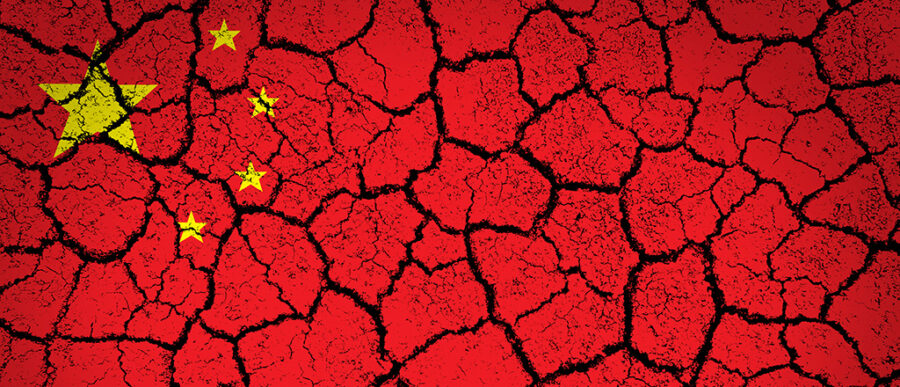Is the music about to stop on China’s debt merry-go-round and throw off the world’s second largest economy? Global financial experts from investor George Soros to the International Monetary Fund have all recently sounded warnings on China’s debt levels. Rapid credit growth driving high levels of investments are “a key fault line in the Chinese economy,” said David Lipton, IMF first managing director at a speech in Shenzhen, China on June 11. Remarked Soros more ominously in April: The Chinese economy’s reliance on debt “eerily resembles what happened during the financial crisis in the U.S. in 2007-2008, which was similarly fueled by credit growth.”
Thanks in large part to domestic stimulus measures post-global financial crisis, China’s total debt has soared from about 150% of GDP in 2008 to 225% of GDP today, according to the IMF. The stimulus kept China’s economy growing in the immediate aftermath of the global financial crisis, helping also to stoke the recoveries of other economies across the globe. Since then, the government has promoted stop-and-go stimulus spending to keep the decelerating economy from flagging further.
The People’s Bank of China has lowered interest rates multiple times in the last two years, as well as cut bank reserve requirements. The last round of stimulus, which began in the middle of last year, is spurring M1 money supply to grow by 22.9% — its fastest pace since the global financial crisis. But now, as the Chinese GDP growth continues to drift down — to 6.7% in the first quarter, a 25-year low, vs. 6.9% last year — the fault lines are beginning to show.
At issue isn’t China’s total debt-to-GDP, which in itself is not out of line by global standards, says the IMF. Nor is it the level of government or household debt, both at 40% of GDP, respectively. Rather, the problem centers on corporate debt, running at a high 145% of GDP, and corporate borrowers’ declining profitability and ability to service the debt in a decelerating economy, especially among the country’s large state-owned enterprises (SOEs), says the IMF.
“Banks are not at the brink of default. If anything, the government still has money to pump into the system to bail out banks.” –Minyuan Zhao
Problem loans now stand at 5.5% of China’s total bank loans, up from 4.4% in 2014, according to official Chinese statistics. The IMF estimates that 15.5% of total commercial bank loans — or $1.3 trillion — to the corporate sector are “at risk,” meaning that companies’ earnings (as defined by earnings before interest, taxes, depreciation and amortization, or EBITDA) cannot cover their interest expense.
Armageddon?
Yet, contrary to Soros’ warnings, Wharton and other experts do not predict a financial crisis around the corner for China. “There is nothing alarming,” says Minyuan Zhao, a Wharton management professor. “Banks are not at the brink of default. If anything, the government still has money to pump into the system to bail out banks. With the implicit endorsement from the government, the likelihood of a bank run or financial crisis is remote.”
Says Horst Loechel, economics professor at the Frankfurt School of Management and visiting professor of economics at the China Europe International Business School (CEIBS) in Shanghai: “In the West, the speculation is always about the Lehman moment in China. That is a Western fantasy. Chinese politicians know what’s coming up and have a plan to manage the bad loans.” Agrees Marshall Meyer, Wharton management professor emeritus: “Is China going to get an Armageddon financial collapse? I don’t think so. If it happened, you’d never know it,” because the officials will have handled it.
Instead, the risk of China’s long-brewing credit overhang is a slow burn that threatens to lay waste to reform objectives to rebalance the economy for the next stage of sustainable development based on domestic consumption, services, and innovation, rather than exports, brute-force investment in heavy industries, and low-skilled manufacturing, say Wharton and other experts. If China isn’t able to reposition, it risks falling into the middle-income trap, stuck with lackluster economic growth and the expenses of caring for an aging population.
Today, more and more credit is going to pay off old credit for unproductive projects rather than to fuel new and productive investments, say experts. Much post-crisis stimulus spending went to projects, from real estate to factory expansions, now proving less viable in a slowing economy than in a fast growing one. Moreover, “the problem is the more you invest, the lower the return on investment,” says Meyer. “In 2007 and early 2008, it took three dollars of investment to generate one dollar of GDP in the U.S. Today, experts say, it takes six dollars of investment to generate one dollar of GDP in China.” Indeed, according to the IMF, SOEs account for 55% of China’s corporate debt but contribute only 22% of GDP.
The consequences of China’s credit overhang aren’t just a worry for the Chinese economy but also for the rest of the world. “In the 1980s, the Soviet Union was piling up capital expenses, but it wasn’t a problem when the Soviet Union collapsed, because they had not been exporting their excess investment,” says Meyer. “If China continues to export its excess capacity, it will slowly ground down economies everywhere, including its own. It’s like the old British bankers’ saying: When you owe the bank a thousand pounds, you have problem; a million pounds, they have a problem; a billion pounds, and everyone has a problem.”
Rescue Playbook
For now, many experts say China’s large state-owned banks will be able to withstand the rise in bad loans. Assuming a 60% loss ratio on the 15.5% of total corporate commercial loans estimated to be at risk, potential bank losses could total $756 billion, or 7% of GDP, according to the IMF. But banks are well equipped to deal with those losses with $1.7 billion of Tier I capital, or 11.3% of system risk-weighted assets, and $356 billion in total reserves on their books, a high domestic savings rate, loyal deposit base, and the Chinese government behind them. “The systemic risk of the banking sector is lower than in the West,” says Loechel, a China banking expert. ”They have a massive amount of deposits and a 17% minimum reserve requirement deposited at the central bank — that’s money in the system independent of a government bailout which can work to improve their balance sheet.”
“In the West, the speculation is always about the Lehman moment in China. That is a Western fantasy.” –Horst Loechel
To manage the bad loans, most likely, the Chinese government will borrow from its playbook from the 1990s and early 2000s, where financial regulators swapped bad debts from state-owned banks’ balance sheets onto the balance sheets of asset management companies supported by the central government, says William Adams, vice president and senior international economist at PNC Financial Services Group in Pittsburgh, Pa. “The asset management companies tried to collect on some of the debts and sell some, but mostly, the size of the debt shrank because of economic growth,” he says. “This time, growth is slower, but if China is able to achieve 3% or even 4% inflation, that would reduce the real value of those debts.” Though in the short-run, low inflation is in store for China and the rest of the world, inflation should pick up in five to seven years as part of the normal business cycle, Adams says.
Moreover, since most of China’s debt is denominated in domestic currency, unlike other emerging market country (EMC) debt crises triggered by foreign currency borrowings, depreciation of the yuan would help reduce the real value of the debt in U.S. dollars, says Adams. “The easiest way to make this problem shrink is for China to allow or encourage faster depreciation, and that would be less painful for the world economy than if China experienced a debt crisis. But a significantly weaker Chinese currency exacerbates the headwinds to global growth, especially for manufacturing exporters in the U.S. and other advanced economies competing with China.”
Crossing the River
Meanwhile, wringing out excess capacity in the economy, whether white elephant real estate or inefficient state owned enterprise operations, is the only lasting fix to China’s state-sponsored credit binge, says Meyer. Then credit can be allocated more efficiently to the new enterprises that will drive China’s next stage of sustainable growth. The Chinese government is taking some steps in this direction with plans to shrink the steel and coal sectors. In addition, across the economy, some defaults are starting to take place with more to come, say experts. In March 2014, Shanghai Chaori Solar Energy Science & Technology Co. became the first domestic corporate bond issuer to default. In April 2015, Baoding Tianwei Group became the first SOE to default, but there is little indication that a spate of SOEs will follow.
“The easiest way to make this problem shrink is for China to allow or encourage faster depreciation, and that would be less painful for the world economy than if China experienced a debt crisis.” –William Adams
Overall, the government is taking a go-slow approach to avoid mass unemployment and social unrest, says Meyer. “It’s almost impossible [to restructure] in the current environment, because the government is not totally secure,” he says. “This is the first government post-1949 that has not had the mantle of Mao or Deng, and it is struggling a bit for legitimacy. If and when they can solve this problem, then they’ll address economic issues. The government is determined long-run to make tough choices, but the question is ‘how long is the long-run?’” With an aging population requiring a costly social safety net and a shrinking workforce, the government has “got to find a way to be globally competitive, innovating, and climbing up the value chain,” says Meyer.
Zhao agrees: “The government knows that only reform can produce further growth, and growth is necessary to reduce debt in the country. But they’re also well aware of the damage reform can create, particularly unemployment. If you push for reform, inefficient SOEs have to go bankrupt or write off bad debt. Then non-performing debt on banks’ balance sheets may trigger more capital outflow.”
The cautious approach has its costs, says Zhao. “Chinese still believe in crossing the river while feeling the stones. But the back-and-forth rhetoric increases uncertainty. The uncertain outlook for reform is so high that many entrepreneurs may hang up their hat for a few years to see what happens. That will slow growth and make the debt overhang even more damaging.” Indeed, she notes, private sector investment grew only 5.2% year-over-year in the first four months of 2016, compared to 25% in 2013 and about 10% in 2015, according to a Xinhua survey.
High debt levels are keeping the government from taking the measures that will ultimately provide the best cure. In the end, “long-term growth is the best medicine,” says Zhao.



